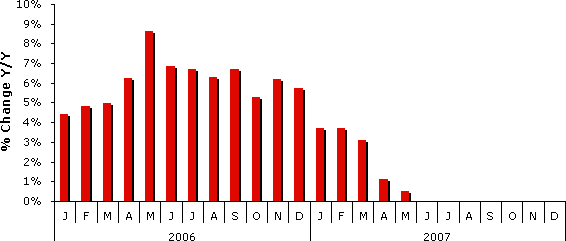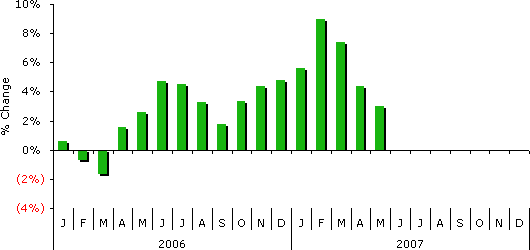IDEX Online Research: Jewelry Price Inflation Continues to Moderate
June 21, 07
It may be time for retail jewelers to breathe a quiet sigh of relief: gross margin pressure from commodity price increases has moderated substantially since the beginning of the year. In May, jewelry supplier prices showed the smallest increase in five years.
If current trends continue, jewelers should be able to enact modest price increases over the next several months that could enable them to report improved gross margins in the all-important fourth calendar quarter.
CPI and PPI Lower in May
Both the Consumer Price Index (CPI) for jewelry and watches and the Producer Price Index (PPI) for jewelry and related items fell again in May. The jewelry CPI reflects retail price trends that consumers pay for jewelry and watches, while the jewelry PPI reflects supplier prices to retailers for jewelry, precious metals, gemstones and other commodities used by merchants.
- The jewelry Producer Price Index edged up by a very modest 0.5 percent (five-tenths of one percent) in May, its smallest gain since October 2002, about five years ago.
- The jewelry Consumer Price index rose by a very modest 3.0 percent in May, the smallest gain this year.
Our outlook calls for the jewelry CPI to stabilize in its current range for the balance of the year, as jewelers take the opportunity to slowly raise their retail prices between now and the holiday selling season to pass along the full amount of price increases related to higher-cost precious metals. The jewelry PPI has likely reach bottom, and will likely rise in subsequent months, perhaps back to the 2-3 percent range. Like retailers, jewelry suppliers face the same daunting task of recouping last year’s raw material cost increases.
For the moment, gasoline prices in the U.S. have moderated somewhat, but that won’t last long. If a hurricane appears to be on the way toward the Gulf Coast, gasoline prices will spike, and consumers’ discretionary dollars will be directed to their gas guzzling cars and SUVs, rather than fashion goods such as jewelry.
Jewelry Producer Price Index Barely Wiggles the Needle
The jewelry Producer Price Index was barely up this month: +0.5 percent (five-tenths of one percent). That was hardly enough to register on the graph below.
The better news is that, after spiking in May 2006, jewelry producer prices have shown a solid retreat, as shown on the graph below.
| U.S. Producer Price Index |
Jewelry Consumer Price Index Reflects Smaller Price Increases
The jewelry Consumer Price Index rose by a very moderate 3.0 percent in May. This was the fourth consecutive month that retail prices for jewelry showed smaller gains versus the same month last year.
While the 3.0 percent price rise in May is still above the average jewelry CPI for 2006 of +2.4 percent, it is headed in the right direction, though it is unlikely to fall much more, if merchants implement planned price increases.
The graph below summarizes the jewelry CPI since the beginning of 2006.
| U.S. Consumer Price Index for Jewelry |
Outlook: We May Have Bottomed
Most forecasters called for a slowing U.S. economy in 2007. American GDP grew by a scant 0.5 percent in the first quarter. The Fed chairman says the U.S. economy is on track for stronger growth in subsequent quarters, and that the bottom was reached late in 2006 and early 2007.
Unfortunately, jewelry is one of the first categories to experience slowing sales when the economy begins to soften, and it is one of the last to recover. Thus, jewelers are faced with the prospects of sluggish demand while trying to raise their prices in hopes of recouping some of the higher costs of commodities that they incurred in 2006. They are climbing a slippery slope, with no easy way up.
We believe that the jewelry PPI has probably reached its ebb in May, and could show an increase in subsequent months. After all, suppliers face the same cost challenges that affect retailers. Likewise, we think that retail prices of jewelry will probably continue to rise in the 2-3 percent range for most of the balance of the year. That should represent a point of equilibrium for retailers to recover higher costs without dampening demand.

